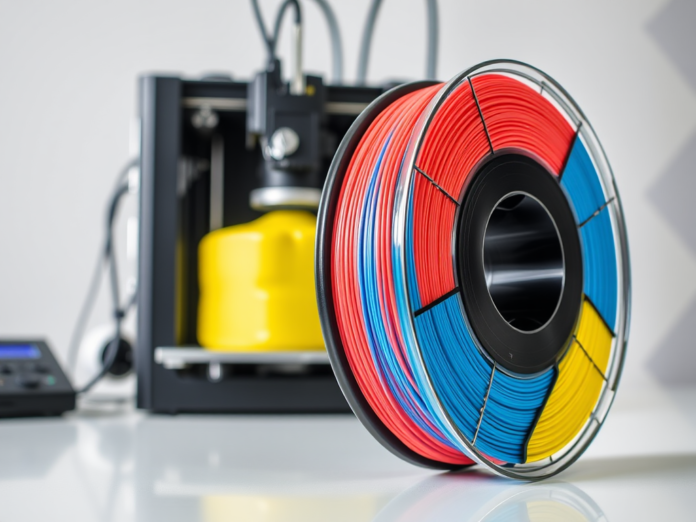Introduction:
Introduction:
3D printing has transformed the way we design and produce everything. But, like any industrial technique, 3D printing can generate byproducts that might not be perfect for the environment or health. One issue connected with conventional 3D printing materials is the emission of Volatile Organic Compounds (VOCS), which can harm human health and indoor air quality. VOC-free 3D printer filaments have surfaced as a safer and more environmentally responsible option to solve this. This paper will investigate what VOC-free 3D printer filament is, its advantages, and why it should be a main priority for both 3D printing pros and hobbyists.

What Are VOCS and Why Should 3D Printing Raise Them?
Chemicals that can readily evaporate into the air at ambient temperature are known as VOCS, or volatile organic compounds. Heating 3D printer filaments like ABS (Acrylonitrile Butadiene Styrene) or PLA (Polylactic Acid) during the printing process can cause VOCS to be released, which might be dangerous chemicals like styrene or formaldehyde.
Exposure to these chemicals, particularly in unventilated areas, can cause a range of health problems, including:
- Headaches
- Lightheadedness
- Irritation of the respiratory system
- Tiredness
- Long-term health issues from continuous exposure
Apart from health issues, VOCS can cause environmental damage and air pollution. For 3D printing fans who print inside or in home offices, the kind of filament being used and the air quality in the work area are crucial factors.
What Is 3D Printer Filament Without VOCS?
Made from materials releasing almost no volatile organic compounds during the printing process, VOC-free 3d printer filament is designed to ensure that the air in your printing area stays clean and safe. For those who print indoors, in limited areas, or without sufficient ventilation, VOC-free filaments are very helpful. Usually made of non-toxic, biodegradable materials, VOC-free filaments do not release harmful compounds when heated. Though with the extra advantage of a safer, more sustainable printing technique, these filaments offer the same excellent printing performance as conventional filaments.
Categories of VOC-Free 3D Printer Filament
3D printing can use a number of VOC-free filaments, each with specific qualities. Here is a breakdown of the most often chosen:
- Polylactic Acid (PLA)
Among the most often used and common 3D printing materials is PLA. Made from renewable resources like corn starch or sugarcane, PLA is an eco-friendly polymer that does not emit dangerous VOCS during the printing process. Perfect for indoor printing, it is non-toxic, biodegradable, and produces fewer emissions. PLA is well-liked by professionals, teachers, and enthusiasts since it also provides excellent printing quality.
Advantages of PLA:
- Non-toxic & VOC-free
- Made from renewable resources, biodegradable
- Simple to print with and needs little temperature management
- Perfect for making ornamental things, prototypes, and models
- Polycarbonate Terephthalate Glycol (PETG)
Another well-liked VOC-free filament, PETG, mixes the finest attributes of ABS and PLA. Known for its excellent print quality, durability, and flexibility, PETG is resistant to impact and moisture, making it an excellent choice for functional prints such as mechanical parts, tools, and enclosures. PETG also generates very little smoke during the printing process, making it suitable for indoor use.
Advantages of PETG:
- Robust and long-lasting
- Low odour emissions, VOC-free
- Resistant to dampness and impact
- Perfect for mechanical components and functional printers
- Thermoplastic Polyurethane (TPU)
A VOC-free, flexible, rubber-like filament called TPU is perfect for making components that need elasticity, including phone covers, wearables, and seals. Known for its shock-absorbing qualities, TPU is suitable for items that need to be bendable or elastic. It’s a standard option for functional printers and prototypes needing flexibility.
Advantages of TPU:
- Rubber-like and flexible
- VOC-free and safe to print inside
- Excellent for creating shock-absorbing, flexible, and bendable components
- Perfect for sealing, phone cases, and wearables
- High Impact Polystyrene (HIPS)
A VOC-free filament usually utilised as a support material in dual extrusion 3D printers, HIPS is easily soluble in limonene, making it ideal for producing complicated geometries and supports for other filaments, including ABS or PLA. Strong, long-lasting components may be made using HIPS, which has excellent impact resistance.
Advantages of HIPS:
- No VOCS and slight smell
- Perfect for use as a support material in twin extrusion systems
- Strength and high impact resistance
- Limonene makes support removal simple by easily dissolving.
Advantages of Using 3D Printer Filament Without VOCS
Especially for individuals worried about health and environmental impact, using VOC-free fibres has several advantages. Some of the main benefits of utilising VOC-free 3D printer filament are listed here.
Health and Safety
By reducing the emission of harmful VOCS, VOC-free filaments create a safer printing environment. Indoor printers, where inadequate ventilation might lead to toxic compounds building up in the air, should pay particular attention to this. Knowing you are not exposing yourself to dangerous fumes, VOC-free filaments let you print with confidence.
Eco-Friendly
Often produced from biodegradable or recyclable materials, VOC-free filaments help to lower their environmental impact. For example, PLA is made from renewable resources like corn starch and sugarcane, making it a sustainable alternative to traditional plastic filaments. These materials also break down with time, hence lowering landfill plastic waste.
No Strong Odours
Traditional filaments like ABS can emit strong, unpleasant odours when heated. VOC-free filaments, on the other hand, typically produce little to no odour, making the printing process more pleasant, especially if you’re printing indoors or in confined spaces.
Better Air Quality
Using VOC-free filaments helps maintain better air quality in your workspace. Since these filaments release fewer harmful chemicals, they contribute to a healthier, cleaner environment for you and those around you.
How to Choose the Right VOC-Free 3d Printer Filament
When selecting a VOC-free 3D printer filament, it’s essential to consider the following factors to ensure you choose the best filament for your needs:
- Print Quality
Consider the type of projects you plan to print. PLA offers excellent print quality for models and decorative items, while PETG is better for functional parts that require durability and strength. TPU is the best choice for flexible, shock-absorbing parts. - Durability
If you need your prints to withstand wear and tear, opt for materials like PETG or HIPS, which offer higher durability than PLA. TPU is also an excellent option for prints that need to be flexible and resistant to impact. - Printer Compatibility
Ensure that the filament you choose is compatible with your 3D printer. Some printers are optimised for specific filaments, and certain materials may require higher extrusion temperatures or different print bed settings. - Ease of Use
If you’re a beginner, PLA is an excellent option because it’s easy to work with and doesn’t require a heated bed or high temperatures. PETG is a good mid-range option for those with some experience in 3D printing, offering a good balance of durability and ease of use.
READ MORE – VEX V5 Battery Holders 3D Print: A Complete Guide for Custom Designs
FAQs:
- What is VOC-free 3D printer filament?
VOC-free 3D printer filament is made from materials that do not release harmful volatile organic compounds during the printing process, ensuring a safer and healthier printing experience. - Which VOC-free filament is best for beginners?
PLA is an excellent choice for beginners as it is easy to print with, produces minimal odour, and doesn’t require a heated bed or high temperatures. - Can VOC-free filaments be used for functional parts?
Yes, filaments like PETG and HIPS are durable and strong, making them perfect for functional parts that require impact resistance and strength. - Are VOC-free filaments environmentally friendly?
Yes, many VOC-free filaments are made from biodegradable or recyclable materials, reducing their environmental impact. - How do I know if a filament is VOC-free?
Check the filament packaging or product description. Many manufacturers will explicitly state whether their filaments are VOC-free or have low emissions.
Conclusion:
Three-dimensional printer filaments free from VOCS provide a safe, eco-friendly alternative to conventional filaments. These filaments are perfect for anyone wanting to make safe and sustainable 3d-printed components since they can generate high-quality prints without emitting dangerous chemicals. Whether you like PLA for its simplicity, PETG for its longevity, or TPU for its adaptability, there is a VOC-free filament appropriate for your 3D printing requirements. Choosing VOC-free alternatives can lead you to a better printing environment and excellent outcomes.



